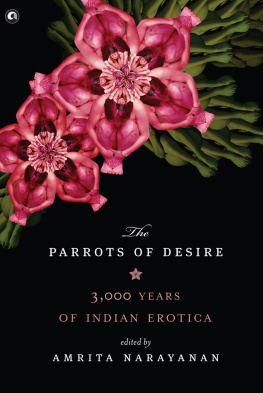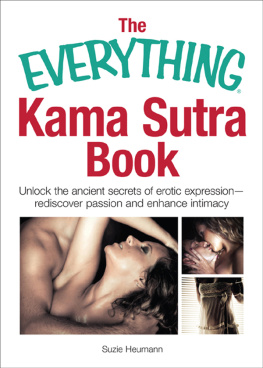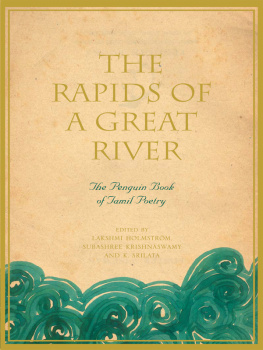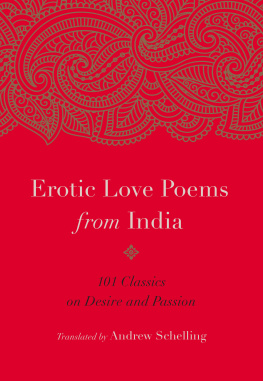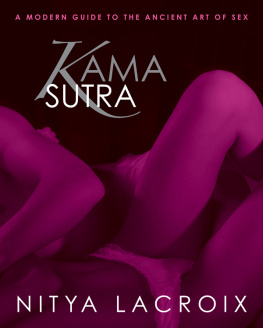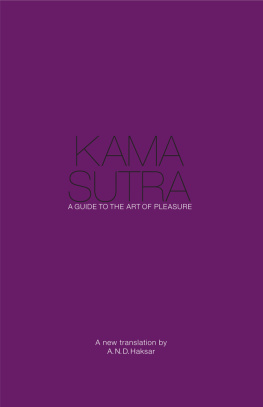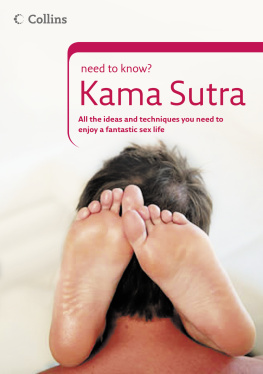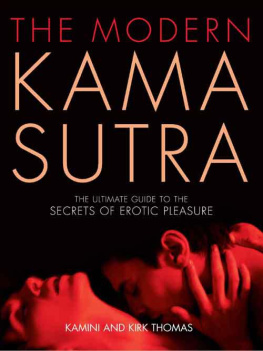The
PARROTS OF DESIRE
Also by Amrita Narayanan
A Pleasant Kind of Heavy and Other Erotic Stories


ALEPH BOOK COMPANY
An independent publishing firm
promoted by Rupa Publications India
Published in India in 2017
by Aleph Book Company
7/16 Ansari Road, Daryaganj
New Delhi 110 002
Anthology Copyright Aleph Book Company 2017
Introduction Copyright Amrita Narayanan 2017
Copyright for the individual pieces and translations vests in the respective authors and translators.
(Notes) are an extension of the copyright page.
While every effort has been made to trace copyright holders and obtain permission, this has not been possible in all cases; any omissions brought to our attention will be remedied in future editions.
All rights reserved.
In the works of fiction in this anthology, names, characters, places and incidents are either the product of the authors imagination or are used fictitiously and any resemblance to any actual persons, living or dead, events or locales is entirely coincidental.
No part of this publication may be reproduced, transmitted, or stored in a retrieval system, in any form or by any means, without permission in writing from Aleph Book Company.
ISBN: 978-93-83064-09-0
1 3 5 7 9 10 8 6 4 2
This book is sold subject to the condition that it shall not, by way of trade or otherwise, be lent, resold, hired out, or otherwise circulated without the publishers prior consent in any form of binding or cover other than that in which it is published.
To the modern reader:
may reading, across time and language,
give you the companionship you need
to stay on the erotic side of the argument
CONTENTS
Brihadaranyaka Upanishad
by Roberto Calasso
by Laurence Hope
by Vidyapati
Amaruataka
Shvetashvara Upanishad
by Bhartrihari
Kama Sutra
Koka Shastra
Who are You Having Sex With?:
The Physical Types and Their Seasons
Koka Shastra
Kama Sutra
by Sudhir Kakar
Bhavakadevi
Mahendra Bhalla
by Kamala Das
Gth Saptaat
tusaram
Gth Saptaat
Gita Govinda
by Tarun Tejpal
by K. Satchidanandan
by Ginu Kamani
Kama Sutra
by Bindu Bhatt
by Deepti Kapoor
by Manjula Padmanabhan
Kama Sutra
by ntl
by Amrita Pritam
by Ammuvanar
Kama Sutra
by Rabindranath Tagore as Bhanusimha Thakurer Padabali
Kuruntokai
Kama Sutra
Amaruataka
Gita Govinda
by Muddupalani
by Pritish Nandy
Amaruataka
Mahabharata
by Jur'at
by Raskhan
by Raskhan
by Krishna Baldev Vaid
Gth Saptaat
by Mahadeviyakka
Amaruataka
by Mridula Garg
by Mirabai
by Ismat Chughtai
by Saadat Hasan Manto
by Silabhattrika
by Ambai
by Govindasvami
by Vidyapati
Gth Saptaat
by Perumal Murugan
Amaruataka
by Kiran Nagarkar
Adivaraha Sattasai
by Kamala Das
Kama Sutra
Paranar
Sattasai
by Manikkavacakar
Tamil Sangam Poetry
by Arundhathi Subramaniam
by Kala Krishnan Ramesh
Kama Sutra
INTRODUCTION
THE EROTIC IN THE INDIAN IMAGINATION
To read centuries of voices writing on the erotic is to become keenly aware of a deep argument that exists in the geography of the subcontinent, an argument between literary romanticswho embrace the erotic for the gloss it adds to lifeand religious traditionalists are in balance; they do not favour the promotion of the erotic, worrying that if not tightly controlled, the erotic could undermine the other three goals of life. Aficionados of the romantic project used the arts as a vehicle of articulation; their literature, music, drama, even grammar, was thought to be imbued with the erotic and capable of enhancing our understanding of the erotic. Traditionalists used both religious writing and the social contract to articulate the dangers of the erotic, believing that the erotic must be kept on the sidelines, aside from its necessary use as a vehicle for reproduction. Romantics believe that coupling is a central life force, and they appreciate the energy that comes from all couplings, whether man-woman, woman-woman, men who identify as women (and are fantasizing about male gods), or (wo)men with God. Traditionalists believe in the notion of an ideal couple: heterosexually and monogamously married, with children and extended family in the foreground and a willingness and ability to keep the erotic in the background.
To further understand the argument between traditionalists and romantics, consider a brief history of the time that traditionalism and romanticism have held sway. The purview of this anthology begins about 1000 BCE in ancient India. For the first 800 years or so of this time period, that is, beginning with the Vedas, traditionalist sentiments prevail. During this time, the destabilizing dangers of the erotic are far better articulated in the literature than are its pleasures. From the Vedas onwards, traditionalist literature, which is largely in the form of religious texts, is squarely articulate on the need to manage the destablizing potential of the erotic. Beginning in 200 BCE, however, and continuing for several centuries, literary voices sang the glories of the erotic and their dedication to itin Tamil, Sanskrit, and Maharashtrian Prakrit. From the second to the sixth century, an Indian literary-erotic-nature idiom was spelt out from Tamil Nadu to Maharashtra and up to Madhya Pradesh. Here the poets embraced the erotic along with its problems, accepting that though the erotic often brought anger, grief and shame, it was still worth embracing for its pleasures. During this medieval period emerged the Tamil Sangam poets and the Maharashtrian Prakrit Gth Saptaat, the prose and poetry of Klids and Bhartrihari, as well as the Kama Sutra itself. After this golden age of the Romantics, puritanism once again holds sway and the next major erotic workat least the one that has survivedis the collection of romantic poems known as the Amaruataka, written in Sanskrit in the seventh or eighth century and attributed to King Amaru of Kashmir. From the eighth century onwards there is again a long period in which very few important works have survived, the next set being from the Bhakti poets who compose discontinuously from the ninth to the fifteenth centuries in praise of erotic love with God himself. The fact that Bhakti poets praise erotic love only in language that involves a deity suggests that this was considered the most elegant and refined expression of romanticism at that time. Alternatively, perhaps, the social climatewhich by this time included both Hindu and Muslim puritansdid not support an articulation of a more explicit person-to-person erotic love. The taboos on self-expression of erotic love might have impinged particularly on women poets and the re-direction of this love to the divine might have spared them the censorship that might have otherwise been forthcoming. Another way of thinking about it is that, dispirited with the limitations of romantic love between humans, some of these poets were able to find a more elevated idiom with the gods.
Following the Bhakti period, the proliferation of the Urdu language and the culture of refinement associated with Islamic courtly love played an important pro-romantic influence; but as the Hindu and Muslim puritans were joined by the British puritans in the seventeenth century, one has the sense that romanticism was very much in the dark ages. Nevertheless, important works continued to emerge in a more scattered fashion. Amongst these individual works are those written by courtesans, such as the Telugu
Next page
